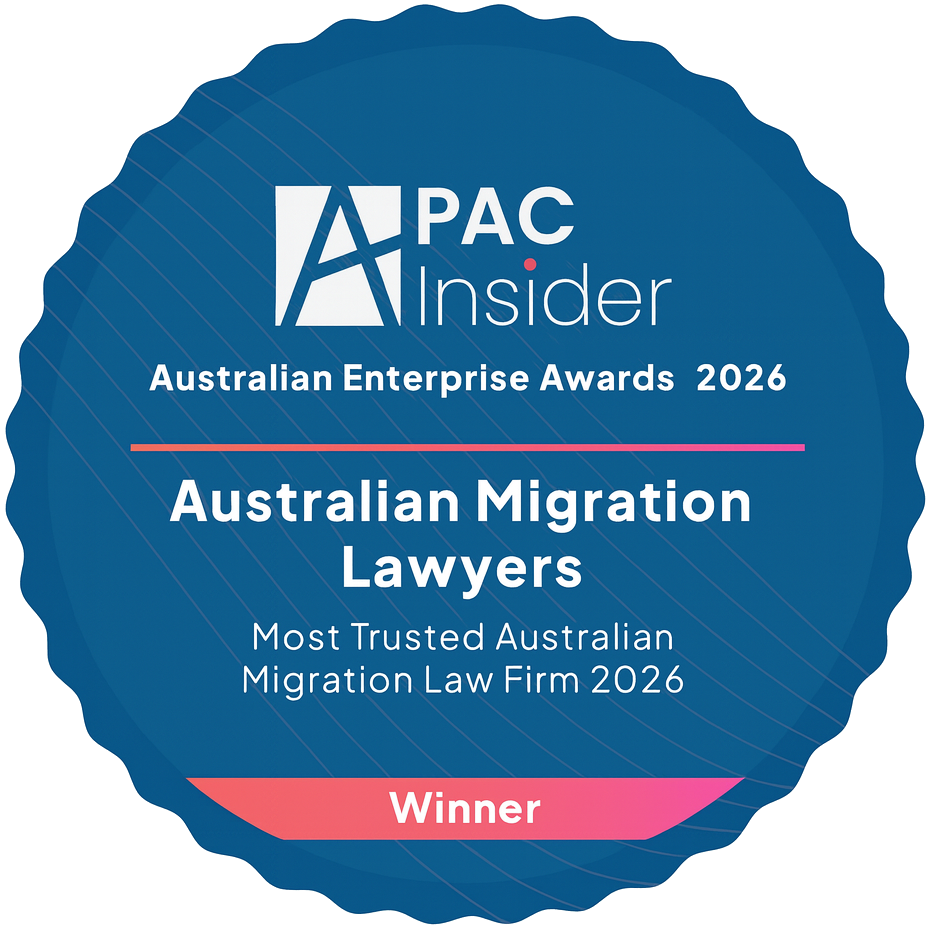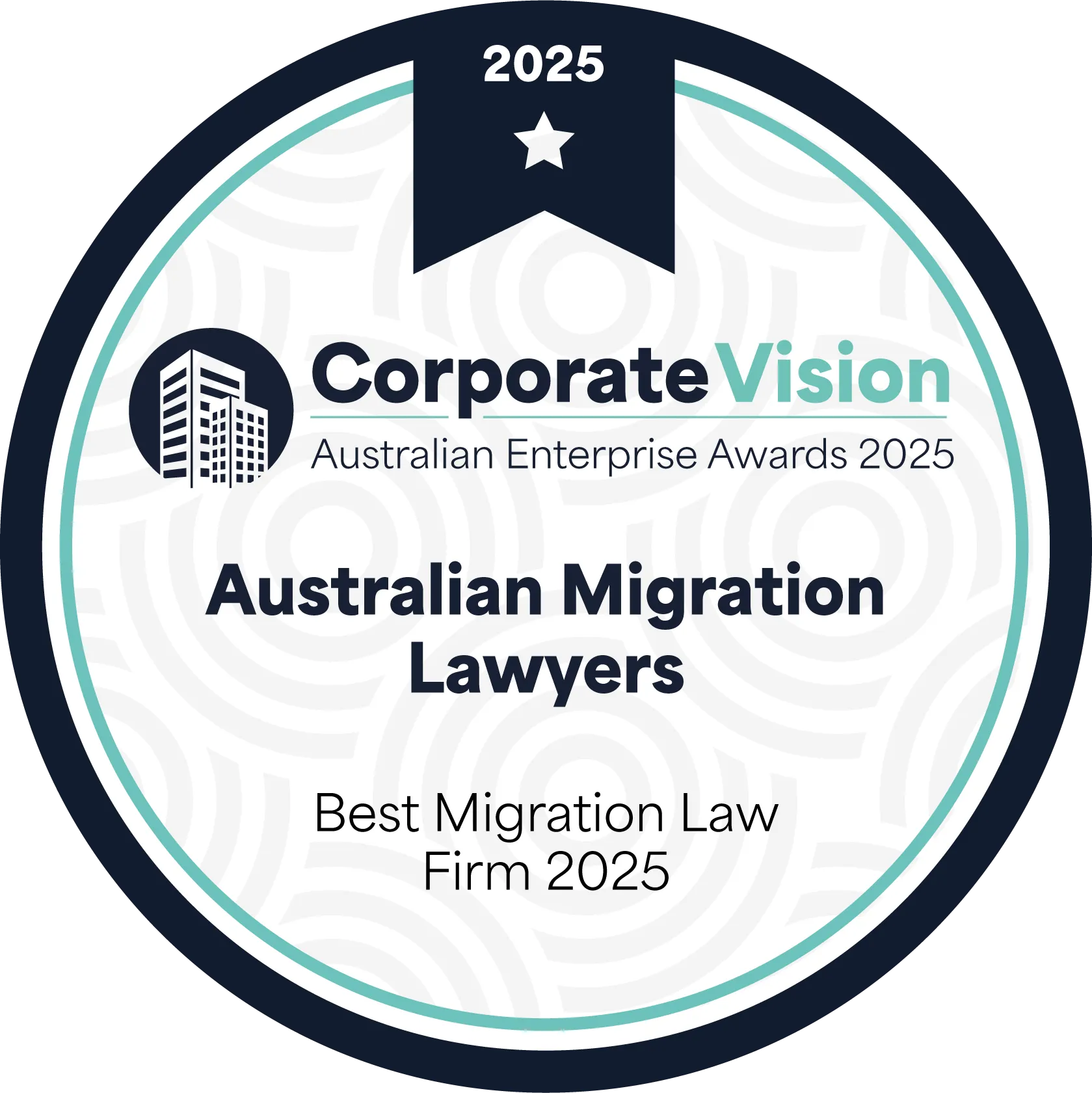Australia's largest independent migration law firm. Open 7 days! Book here.
Need help? We are available 7 days a week.

.webp)

Winner of Most Trusted Australian Migration Law Firm 2023-2026

Ranked 1st for migration law in 2023, 2024 & 2025

Ranked in the top migration lawyers 2023, 2024 & 2025

Ranked the best migration law firm 2024 & 2025

The Employer Nomination Scheme visa (subclass 186) is a visa that lets skilled workers, who are nominated by an employer, live and work in Australia permanently. It is available to skilled workers in occupations listed in the Department’s skilled occupation lists.
The 186 visa is split into three streams, being the Temporary Residence Transition (TRT), Direct Entry (DE), and Labour Agreement (LA) streams. Depending on the stream that you apply for, applicants will generally need to have two (TRT) or three (DE) years work experience and, for the DE stream, must have a positive skill assessment. The visa also requires nomination from an Australian employer that is actively and lawfully operating a business in Australia.
If these requirements are met, the applicant may be eligible to apply for the 186 visa and will become a permanent resident of Australia once granted. There are many benefits to being a Permanent Resident in Australia, including a path to Australian Citizenship.
For employers, the 186 visa is generally used as retaining existing foreign workers who are currently holding a subclass 482 Temporary Skill Shortage visa. The 482 leads directly to PR through the 186 visa, specifically in the TRT stream, which allows a 482 visa holder to apply for permanent residence after two years of full-time work on the 482.
While this is the more common use of the 186 visa, it is also possible for skilled applicants to apply for the 186 visa directly without having held a previous work visa if they apply in the Direct Entry stream. The visa has the same benefits as the TRT stream, however the skills requirements for the visa applicant are slightly higher, requiring a positive skills assessment and minimum of three years relevant work experience.
Lastly, the Labour Agreement stream relates to employers that are currently party to a work or labour agreement with the Department of Immigration.
Step 1: The first step in applying for a 186 visa, is ensuring that you are eligible for the visa and have an employer who is willing to sponsor you with a nomination. The nomination must be lodged before the visa application, and outlines the employment conditions and details of the position. Your eligibility will depend on your occupation, work history, skills and qualifications.
Step 2: You must prepare your application and gather all the required documents. This may include evidence of your English proficiency, a positive skills assessment, work reference letters, qualifications and details related to the health and character requirements. Preparing your application thoroughly at this stage will promote the likelihood of a successful and timely application.
Step 3: The application must be submitted online using your ImmiAccount. While visa processing times are subject to change, you can use the Department’s visa processing time tool to estimate the processing time. At the time of writing this article, 50% of applications were processed within 4 months, and 90% were processed within 10 months. Once your application is submitted, you can check the status of your application through your ImmiAccount portal and register to receive notification of any updates.
Step 4: Occasionally the Department may issue a request for further information before they determine your application outcome. It is important to respond to these requests in a timely manner and provide all the documents that have been requested. Doing so will increase your chances of attaining a favorable visa outcome. Once your application has been assessed you will receive notification of your outcome.
Step 5: If your application is accepted, you will be granted an Employer Nomination Scheme 186 visa. This will grant you permanent residence in Australia. Your obligations and conditions will vary slightly depending on what stream you applied under. You can check the specific conditions that apply to your visa through your ImmiAccount. If your visa is refused, there may be options open to you to appeal the decisions either through Australia’s Administrative Review Tribunal or through the Federal Court.
For an employer seeking to nominate an applicant, the eligibility differs slightly depending on the stream you seek to nominate them under (see eligibility below). However, the application process is relatively similar.
Step 1: It is important to ensure that the employee that you seek to nominate is in fact eligible and appropriate for the specific visa stream that you plan to nominate them under (see eligibility below). This may also require checking the eligibility of your business to ensure that you are a suitable nominee.
Step 2: Once you have determined the relevant stream, it is necessary to prepare all requisite documents (see ‘Documents required’ section below). This may take some time, therefore it is advisable to begin early in order to leave ample time to track down all documents/information required.
Step 3: Your nomination application can be completed from within your ImmiAccount online. You can also pay any associated fee through this portal, as well as registering for notifications on the progress of your nomination. Sometimes, the Department may issue a request for further information before they determine your nomination outcome. It is important to respond to these requests in a timely manner and provide all the documents that have been requested. Equally, you are required to update your nomination is any of the details of your business change (eg. business name, ABN or TRN).
Step 5: If your nomination is accepted, you will receive the approved nomination which will be valid for six months. Any obligations or conditions on your position as nominee may vary slightly depending on what stream you applied under. If your nomination is refused, reasons will be supplied and there may be options open to you to appeal the decisions either through Australia’s Administrative Review Tribunal or through the Federal Court.
[free_consultation]Book a consultation[/free_consultation]
Eligibility requirements for a 186 visa application depend on the stream you are applying under. The table below outlines the eligibility criteria for both applicants and nominees under each stream, sourced from the Department of Home Affairs.
[table]
[thead]
[tr]
[th]Stream [/th]
[th]Applicantion Eligibility [/th]
[th]Nominee Eligibility [/th]
[/tr]
[/thead]
[tbody]
[tr]
[td]Requirements for all streams[/td]
[td]
[/td]
[td]
[/td]
[/tr]
[tr]
[td]Additional requirements for: Direct Entry [/td]
[td]
[/td]
[td]
[/td]
[/tr]
[tr]
[td]Additional requirements for: Labour Agreement [/td]
[td]
[/td]
[td]
[/tr]
[/tr]
[tr]
[td]Additional requirements for: Temporary Residence Transition [/td]
[td]
[/td]
[td]
[/td]
[/tbody]
[/table]
Under the Direct Entry stream, only applicants from the following professions are eligible (please see the Department of Home Affairs search tool for more information)
Senior Management and Executives:
Arts and Entertainment Management:
Financial Management and Consulting:
Architecture and Engineering:
Agriculture and Environmental Sciences:
Healthcare and Medical Professionals:
Education and Training:
Information and Communication Technology (ICT):
Legal and Social Services:
Trades and Technical Professions:
[aml_difference][/aml_difference]
If your 186 visa application has been refused then you may seek to appeal the decision. It is important to engage a knowledgeable lawyer at this time as the appeals process can be difficult to navigate, and having strong legal representation can be highly advantageous to your appeal.
At Australian Migration Lawyers, we possess the expertise and knowledge of immigration laws and regulations necessary to effectively navigate the appeals process. We can provide invaluable guidance on the steps to take, assist in gathering necessary evidence, and prepare a strong case to present before the Australian Administrative Appeal Tribunal or the Federal Court.
Having strong legal representation is vital as it ensures that your appeal is presented comprehensively and persuasively. A skilled lawyer can identify any legal issues or grounds for appeal, address them effectively, and advocate on your behalf to maximize the likelihood of a favorable outcome.
Once you have applied for your 186 visa you will need to wait for an outcome on the nomination and visa. As described above, processing times can be difficult to determine and will vary on a case-by-case basis.
You will automatically be granted a bridging visa in most cases when you apply onshore, so if your existing visa expires prior to the decision on your application, the bridging visa will be initiated. This bridging visa permits you to remain in Australia while the new application is being processed.
You are able to add family members to your visa after you have applied, but before an outcome has been decided, and you are obliged to tell the Departament if anything changes regarding the details of your application. You are not necessarily required to be/remain in Australia whilst your application is processed. If you do decide to leave Australia while the visa is being processed, you should ensure that you will have a valid visa when you return.
You will be notified of the outcome in writing, and if refused, you will be advised whether you have the right to a review of the decision.
[aus_wide_service][/aus_wide_service]
If you require assistance with your application, there are several avenues available to you. Firstly, if you wish for someone to receive your correspondence or represent you, you can nominate them by completing Form 956A, known as the Appointment or Withdrawal of an Authorized Recipient. Additionally, if you require professional immigration assistance, such as guidance from a registered migration agent, legal practitioner, or an exempt individual, you can appoint them using Form 956. Both forms can be submitted through ImmiAccount, the Department’s online portal. It's important to choose someone you trust and who is knowledgeable about the immigration process to ensure your application is handled effectively.
Additionally, you may require assistance translating your documents. When including documents in languages other than English in your application, it is essential to have them translated into English. Ensure that both the original documents and their translations are provided. If you're obtaining translations within Australia, it's important to use translators accredited by the National Accreditation Authority for Translators and Interpreters (NAATI). However, translators located outside Australia do not necessarily need accreditation. Regardless, each translation should include the translator's full name, address, and telephone number, along with details of their qualifications and experience in the language being translated. These particulars must be provided in English for clarity and verification purposes.

We have created comprehensive visa guides that outline the ins and outs of visa applications. Get yours today.